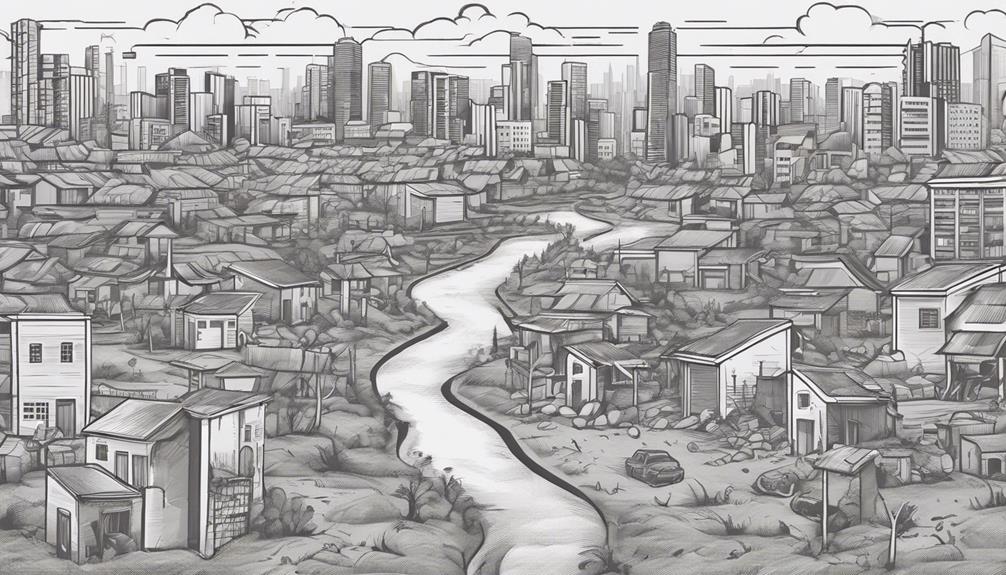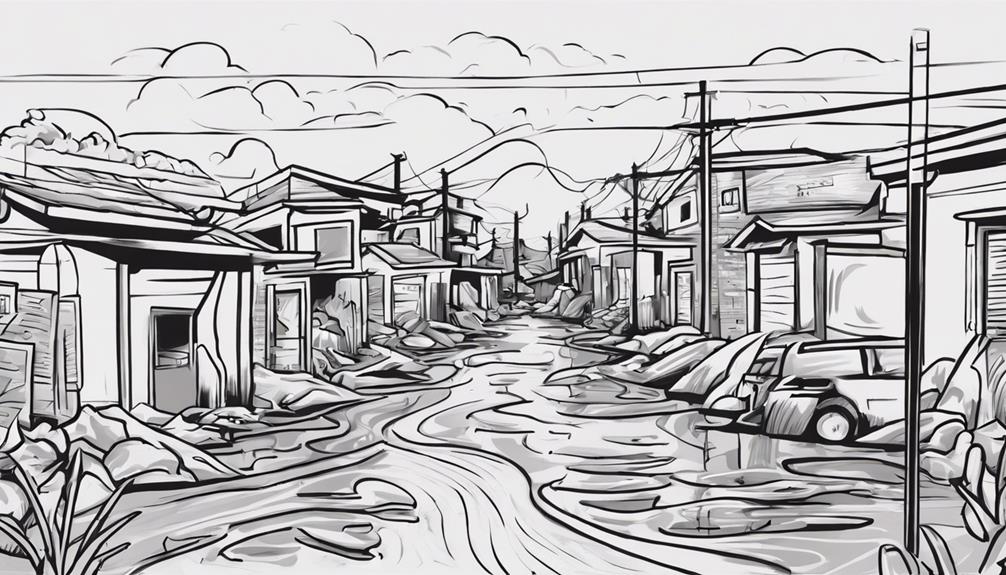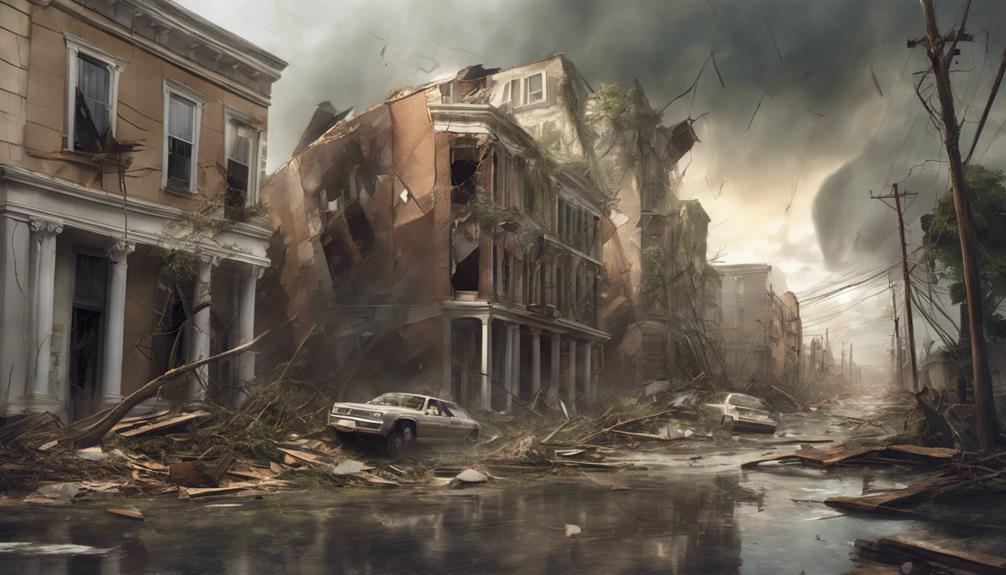When considering the varying levels of destructiveness observed in natural disasters, it becomes evident that numerous factors intersect to influence the outcome. The interaction between the characteristics of the hazard, the susceptibility of the affected population, and the level of preparedness in place creates a complex web of variables that ultimately determine the scale of devastation. By examining the intricacies of geographic location, population density, and socioeconomic disparities, we can begin to unravel the reasons behind why some natural disasters leave a more profound impact than others.
Key Takeaways
- Geographic location and topography determine disaster risk levels.
- Magnitude and intensity of natural disasters impact their destructiveness.
- Population density and urbanization increase vulnerability to disasters.
- Preparedness, response strategies, and socioeconomic factors influence disaster resilience.
Geographic Location and Topography

The geographic location and topography of an area are fundamental factors that determine the level of destructiveness natural disasters can inflict. Specific features such as proximity to fault lines, coastlines, and unstable terrain play a crucial role in influencing the intensity and impact of such events. Areas located near fault lines are at a higher risk of experiencing devastating earthquakes, while coastal regions face increased vulnerability to destructive hurricanes and storm surges due to their proximity to the ocean and low-lying elevation. Additionally, regions with mountainous topography are prone to landslides and flash floods, which can amplify the destructive potential of natural disasters. Urban areas situated in earthquake-prone zones or floodplains are particularly at risk due to high population density, concentration of infrastructure, and limited escape routes, leading to heightened levels of destruction and loss of life. Understanding the interplay between geographic location, topography, and human settlements is essential for effective disaster preparedness and mitigation strategies.
Magnitude and Intensity of the Disaster
Geographic location and topography significantly influence the magnitude and intensity of natural disasters, shaping the destructive potential they possess. The magnitude of a natural disaster, whether it be an earthquake or a hurricane, plays a crucial role in determining its destructive capacity. Events with higher magnitudes release more energy, resulting in increased intensity and impact on the affected region. Quantifying this destructive force is possible through intensity measures such as the Richter scale for earthquakes and the Saffir-Simpson scale for hurricanes. Various factors including speed, size, and duration contribute to the overall intensity and subsequent destructiveness of such disasters. Understanding the magnitude and intensity of a natural disaster is paramount for evaluating its potential impact on both lives and infrastructure. By comprehending these aspects, authorities can better prepare for and respond to the varying levels of devastation that different natural disasters can bring.
Population Density and Urbanization

Influence of population density and urbanization on the impact of natural disasters is a critical aspect of disaster risk management and mitigation strategies. Higher population density in urban areas significantly increases the potential for greater casualties and property damage when disasters strike. Urbanization plays a key role in concentrating infrastructure and population, thereby amplifying the impact of events such as earthquakes and hurricanes. The limited space in urban settings often leads to overcrowding, complicating evacuation and response efforts during disasters. Moreover, urban areas are characterized by intricate interconnected systems that are prone to failure during disasters, magnifying their destructive consequences. Rapid urban growth lacking proper planning and infrastructure development further heightens vulnerability to natural disasters, as inadequate structures and systems are ill-prepared to withstand such events. Understanding the dynamics of population density and urbanization is crucial for effective disaster preparedness and response strategies to mitigate the impact of disasters on urban communities.
Preparedness and Response Strategies
Given the critical role of population density and urbanization in magnifying the impact of natural disasters, the focus now shifts towards discussing effective preparedness and response strategies to mitigate the devastating consequences on urban communities.
- Effective preparedness strategies can significantly reduce the impact of natural disasters by ensuring timely response and resource allocation.
- Community involvement in disaster preparedness enhances resilience and facilitates coordinated response efforts.
- Early warning systems play a crucial role in alerting populations to imminent disasters, allowing for evacuation and mitigation measures.
These strategies are essential for minimizing the destructive effects of natural disasters on urban areas. Investment in infrastructure resilience, adequate training of emergency response teams, and the establishment of early warning systems are crucial components in enhancing disaster response capabilities. By prioritizing these measures, communities can better prepare for and respond to natural disasters, ultimately reducing the overall impact on both lives and infrastructure.
Socioeconomic Factors and Vulnerable Communities

Socioeconomic disparities significantly impact the vulnerability of communities during natural disasters, exacerbating the challenges faced by socioeconomically disadvantaged populations. Vulnerable communities, often socioeconomically disadvantaged, are at higher risk due to limited resources for preparedness and recovery. Factors such as substandard housing in poorer areas increase vulnerability, leading to more significant damage and casualties. Marginalized communities, with limited access to resources and infrastructure, struggle to cope with and rebound from natural disasters effectively. Socioeconomic disparities play a crucial role in determining the resilience of communities, with economically disadvantaged groups encountering greater difficulties in mitigating the impacts of destructive natural events. To address these challenges, investing in disaster-resistant infrastructure and resources for vulnerable communities is essential. By prioritizing the development of these communities and ensuring they have the necessary support systems in place, the destructive effects of natural disasters can be reduced, and the overall resilience of these vulnerable populations can be enhanced.
Frequently Asked Questions
What Natural Disaster Causes More Damage?
Natural disasters vary in their destructive potential. Factors such as hurricane intensity, tornado impact, flood severity, tsunami destruction, volcano eruption, wildfire spread, landslide risk, and blizzard aftermath all contribute to the extent of damage caused. Understanding the unique characteristics of each disaster type, their mechanisms of impact, and the vulnerabilities they exploit is crucial in assessing and mitigating their overall damage potential.
Why Do Some Earthquakes Do More Damage Than Others?
When examining earthquake damage disparities, factors such as building resilience, structural integrity, ground shaking intensity, seismic waves' propagation, soil liquefaction susceptibility, fault line proximity, population density, and emergency response capabilities play pivotal roles. Understanding why certain earthquakes inflict more devastation than others necessitates evaluating the interplay of these elements. By emphasizing earthquake-resistant construction practices, enhancing emergency preparedness, and considering geological nuances, communities can better safeguard against seismic risks.
What Is the Most Destructive Natural Disaster?
The most destructive natural disaster historically was the 2004 Indian Ocean earthquake and tsunami, causing over 230,000 fatalities. Tsunami impact can be catastrophic due to their immense force and reach. Hurricane intensity, tornado formation, flood severity, volcano eruptions, wildfire spread, drought effects, and avalanche risk also pose significant threats. Understanding the factors contributing to each type of disaster's destructiveness can aid in enhancing early warning systems and disaster preparedness measures.
Why Are Earthquakes the Most Destructive Natural Disaster?
Earthquakes stand out as highly destructive due to a combination of factors. The intense ground shaking they generate can severely compromise building codes and structural integrity. When seismic activity occurs near densely populated areas, the risks of casualties and infrastructure damage escalate. Tsunami threats further heighten the devastation. Implementing earthquake-resistant construction practices is crucial to mitigating the destructive impact of these natural disasters.
Conclusion
In conclusion, the varying levels of destructiveness seen in natural disasters can be attributed to a combination of factors such as geographic location, magnitude, population density, preparedness, and socioeconomic disparities. While some may argue that natural disasters are purely random events, it is important to recognize the influence of these factors in determining the impact of such events. By understanding and addressing these factors, we can better mitigate the destructiveness of future disasters.
